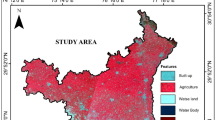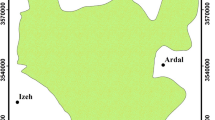Abstract
The soil loss caused by rainfall-runoff process is a global issue which can decrease the lands fertility and increase the flood hazards. There are many different empirical relationships and numerical methods available for soil loss estimation. One of the most commonly used methods is the Universal Soil Loss Equation (USLE), which is widely used to estimate the amount of annual rill erosion. The main aim of this paper was to evaluate the accuracy and applicability of the USLE method in the estimation of soil loss in elevated and rocky mountainous areas of Tibetan plateau. To do this, some of the observed and modeled soil loss data that were available in some Chinese researches, were selected. Land slope, soil type, land cover, Normalized Difference Vegetation Index (NDVI), aspect, monthly and annual rainfall and runoff maps from GIS were derived and investigated to calculate the USLE parameters. The results showed that the accuracy of the USLE model was decreased significantly in regions with high soil loss risk due to ignoring the rock properties and snow cover in K parameter. Also, the results showed that parameters which can decrease the soil loss significantly such as rock fragments content and low height vegetation have to be considered in NDVI calculation. Hence, it is recommended to improve the accuracy of the model by adjusting C factor for elevated mountainous areas based on the rock properties and snow cover which can be derived from the remote sensing maps.






Similar content being viewed by others
References
Benavidez, R., Jackson, B., Maxwell, D., & Norton, K. (2018). A review of the (Revised) universal soil loss equation ((R) USLE): With a view to increasing its global applicability and improving soil loss estimates. Hydrology and Earth System Sciences, 22(11), 6059–6086.
Bols, P. (1978). The Iso-erodent map of java and madura. Belgian Technical Assistance project ATA 105. Soil Research Institute, Bogor.
Cetin, M. (2019). The effect of urban planning on urban formations determining bioclimatic comfort area’s effect using satellitia imagines on air quality: A case study of Bursa city. Air Quality, Atmosphere and Health, 12(10), 1237–1249.
Cetin, M., Adiguzel, F., Gungor, S., Kaya, E., & Sancar, M. C. (2019). Evaluation of thermal climatic region areas in terms of building density in urban management and planning for Burdur, Turkey. Air Quality Atmosphere and Health, 12(9), 1103–1112.
Cetin, M., & Sevik, H. (2016). Evaluating the recreation potential of Ilgaz Mountain National Park in Turkey. Environmental Monitoring and Assessment, 188(1), 52.
Cetin, M., Sevik, H., Canturk, U., & Cakir, C. (2018a). Evaluation of the recreational potential of Kutahya Urban Forest. Fresenius Environmental Bulletin, 27(5), 2629–2634.
Cetin, M., Zeren, I., Sevik, H., Cakir, C., & Akpinar, H. (2018b). A study on the determination of the natural park’s sustainable tourism potential. Environmental Monitoring and Assessment., 190(3), 167.
Devatha, C. P., Deshpande, V. C., & Renukaprasad, M. S. (2015). Estimation of soil loss using USLE model for Kulhan Watershed, Chattisgarh-A case study. Aquatic Procedia, 4, 1429–1436.
Di Stefano, C., & Ferro, V. (2011). Measurements of rill and gully erosion in Sicily. Hydrological Processes, 25(14), 2221–2227.
Durigon, V. L., Carvalho, D. F., AntuneS, M. A. H., OliveirA, P. T. S., & Fernandes, M. M. (2014). NDVI time series for monitoring RUSLE cover management factor in a tropical watershed. International Journal of Remote Sensing, 35, 441–453.
Ferro, V. (1997). Further remarks on a distributed approach to sediment delivery. Hydrological Sciences Journal, 42(5), 633–647.
Ferro, V., & Minacapilli, M. (1995). Sediment delivery processes at basin scale. Hydrological Sciences Journal, 40(6), 703–717.
Fu, B. J., Liu, Y., Lu, Y. H., He, C. S., Zeng, Y., & Wu, B. F. (2011). Assessing the soil erosion control service of ecosystems change in the Loess Plateau of China. Ecological Complexity, 8, 284–293.
Hickey, R. (2000). Slope angle and slope length solutions for GIS. Cartography, 29(1), 1–8.
Immerzeel, W. W., Van Beek, L. P., & Bierkens, M. F. (2010). Climate change will affect the Asian water towers. Science, 328(5984), 1382–1385.
Jian, S., Yu, L., Tiancai, Z., Guohua, L., & Jingsheng, W. (2019). Soil conservation service on the Tibetan Plateau, 1984–2013. Earth and Environmental Science Transactions of the Royal Society of Edinburgh, 109(3–4), 445–451.
Kaya, E., Agca, M., Adiguzel, F., & Cetin, M. (2019). Spatial data analysis with R programming for environment. Human and Ecological Risk Assessment: An International Journal, 25(6), 1521–1530.
Lee, J. H., & Heo, J. H. (2011). Evaluation of estimation methods for rainfall erosivity based on annual precipitation in Korea. Journal of Hydrology, 409(1–2), 30–48.
Lin, B. S., Chen, C. K., Thomas, K., Hsu, C. K., & Ho, H. C. (2019). Improvement of the K-factor of USLE and soil erosion estimation in Shihmen reservoir watershed. Sustainability, 11(2), 355.
Lin, B. S., Thomas, K., Chen, C. K., & Ho, H. C. (2016). Evaluation of soil erosion risk for watershed management in Shenmu watershed, Central Taiwan using USLE model parameters, Central Taiwan. Paddy and Water Environment, 14, 19–43.
Lin, W. T., Lin, C. Y., & Chou, W. C. (2006). Assessment of vegetation recovery and soil erosion at landslides caused by a catastrophic earthquake: A case study in Central Taiwan. Ecological Engineering, 28(1), 79–89.
Mhangara, P., Kakembo, V., & Lim, K. J. (2012). Soil erosion risk assessment of the Keiskamma catchment, South Africa using GIS and remote sensing. Environmental Earth Sciences, 65(7), 2087–2102.
Mikhailova, E. A., Bryant, R. B., Schwager, S. J., & Smith, S. D. (1997). Predicting rainfall erosivity in Honduras. Soil Science Society of America Journal, 61(1), 273–279.
Patil, R. J., & Sharma, S. K. (2013). December. Remote sensing and GIS based modeling of crop/cover management factor (C) of USLE in Shakker river watershed. In: International Conference on Chemical, Agricultural and Medical Sciences (CAMS-2013), Dec, 29–30.
Peng, X., Shi, D., Jiang, D., Wang, S., & Li, Y. (2014). Runoff erosion process on different underlying surfaces from disturbed soils in the three gorges reservoir area, China. CATENA, 123, 215–224.
Renard, K. G., & Freimund, J. R. (1994). Using monthly precipitation data to estimate the R-factor in the revised USLE. Journal of Hydrology, 157(1–4), 287–306.
Sharply, A. N., & Williams, J. R. (1990). EPIC-erosion/productivity impact calculator I, Model documentation. U.S. Department of AgricultureTechnical Bulletin, No. 1768.
Stone, R. P., & Hilborn, D. (2012). Universal soil loss equation, USLE. Ministry of agriculture, food and rural affairs, agriculture and rural. Replaces OMAFRA Factsheet, http://www.omafra.gov.on.ca/english/engineer/facts/12-051.htm.
Teh, S. H. (2011). Soil erosion modeling using RUSLE and GIS on Cameron highlands, Malaysia for hydropower development (Doctoral dissertation).
Teng, H. F., Jie, H. U., Yue, Z., Zhou, L. Q., & Zhou, S. H. I. (2019). Modelling and mapping soil erosion potential in China. Journal of Integrative Agriculture., 18(2), 251–264.
Teng, H., Liang, Z., Chen, S., Liu, Y., Rossel, R. A. V., Chappell, A., Yu, W., & Shi, Z. (2018). Current and future assessments of soil erosion by water on the Tibetan Plateau based on RUSLE and CMIP5 climate models. Science of the Total Environment, 635, 673–686.
Van der Knijff, J. M., Jones, R. J. A., & Montanarella, L. (2000). Soil erosion risk assessment in Europe, European Commission, European Soil Bureau (June. 5, 2009).
Van Remortel, R. D., Hamilton, M. E., & Hickey, R. J. (2001). Estimating the LS factor for RUSLE through iterative slope length processing of digital elevation data within Arclnfo grid. Cartography, 30(1), 27–35.
Van Remortel, R. D., Maichle, R. W., & Hickey, R. J. (2004). Computing the LS factor for the revised universal soil loss equation through array-based slope processing of digital elevation data using a C++ executable. Computers and Geosciences, 30(9–10), 1043–1053.
Vemu, S., & Pinnamaneni, U. B. (2012). Sediment yield estimation and prioritization of watershed using remote sensing and GIS. International Archives of the Photogrammetry, Remote Sensing and Spatial Information Sciences, 39(B8), 529–533.
Williams, J. R. (1975). Sediment routing for agricultural watersheds 1. JAWRA Journal of the American Water Resources Association, 11(5), 965–974.
Wischmeier, W. H., & Smith, D. D. (1978). Predicting rainfall erosion losses: A guide to conservation planning. Washingon: Department of Agriculture Science and Education Administration.
Yu, B., & Rosewell, C. J. (1996). Technical notes: A robust estimator of the R-factor for the universal soil loss equation. Transactions of the ASAE, 39(2), 559–561.
Zhang, H., Wei, J., Yang, Q., Baartman, J. E., Gai, L., Yang, X., et al. (2017). An improved method for calculating slope length (λ) and the LS parameters of the revised universal soil loss equation for large watersheds. Geoderma, 308, 36–45.
Zhang, H., Yang, Q., Li, R., Liu, Q., Moore, D., He, P., et al. (2013). Extension of a GIS procedure for calculating the RUSLE equation LS factor. Computers and Geosciences, 52, 177–188.
Zhou, P., Luukkanen, O., Tokola, T., & Nieminen, J. (2008). Effect of vegetation cover on soil erosion in a mountainous watershed. CATENA, 75(3), 319–325.
Acknowledgements
This research was supported by the “Chinese National Natural Science Foundation” (No. 41871072), “National Major Science and Technology Program for Water Pollution Control and Treatment” (2017ZX07101001) and “Young Scientists Exchange Program (TYSP)” (Grant nos. Iran-18-008 and Iran-18-009). The authors wish to give thanks to the “Geospatial Data Clod Platform” for sharing data for use in this research and the “Institute of Mountain Hazards and Environment” of China for their support, and also they are grateful to Mr. Jian Hong-Mau for providing some photographs. The Iranian authors would like to express great appreciation to the “Vice presidency for Science and Technology” of Iran and the “Ministry of Science and Technology” of China for their cooperation as a part of Memorandum of Understanding on Iran-China on Young Scientists Exchange Program which signed on April 2017.
Artemis and Majid are grateful to the Buein Zahra Technical University (Iran) and Imam Khomeini International University of Iran for extending all possible assistance for the completion of the studies.
Author information
Authors and Affiliations
Corresponding author
Additional information
Publisher's Note
Springer Nature remains neutral with regard to jurisdictional claims in published maps and institutional affiliations.
Rights and permissions
About this article
Cite this article
Fan, J., Motamedi, A. & Galoie, M. Impact of C factor of USLE technique on the accuracy of soil erosion modeling in elevated mountainous area (case study: the Tibetan plateau). Environ Dev Sustain 23, 12615–12630 (2021). https://doi.org/10.1007/s10668-020-01133-x
Received:
Accepted:
Published:
Issue Date:
DOI: https://doi.org/10.1007/s10668-020-01133-x




